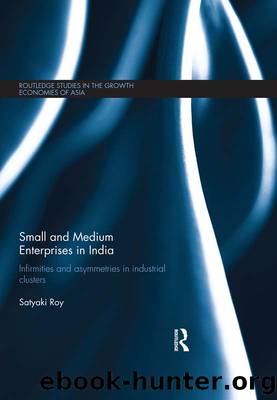Small and Medium Enterprises in India by Roy Satyaki;

Author:Roy, Satyaki;
Language: eng
Format: epub
ISBN: 1125231
Publisher: Taylor & Francis Group
Relying on fluid labor
The region is endowed with a regular flow of a large number of migrant laborers who came from the neighboring districts of Uttar Pradesh, Bihar and also from Orissa and West Bengal. As reported by a labor contractor in Gurgaon the owners prefer not to employ local residents in their units: local residents might have some connection with the legal or illegal power entities of the locality and that might add to their bargaining strength vis-Ã -vis the owner. Owners prefer migrant laborers because they are usually more vulnerable and hence more docile. Since there is no trade union, labor rights can be easily ignored if the share of migrant labor increases in the workforce. This is primarily because migrant workers are relatively less concerned about their rights and welfare and are often inclined to earn more even if that involves higher exploitation and coercion. Most of the workers of garment units in NOIDA and Gurgaon stay at adjacent villages or commute from places where they can stay at low rents. However, during harvesting and sowing seasons most of the workers go back to their home villages to work in the agricultural field, either on what little land they have or to earn more as agricultural labor during peak seasons. This does not cause much of a problem in the supply of labor because the incidence of fluctuations in supply is low compared to the total supply of labor, and also the peak seasons in agriculture and exports in garments do not overlap.
In the case of Manesar it is reported that the availability of labor for the garment factories becomes a problem because of the underdeveloped civic amenities in the emerging industrial center. People moved away from Delhi and Gurgaon and set up new factories in Manesar because of the low price of land and infrastructure, but people who would work in these factories do not have suitable low cost places to stay. Some of the factories used to carry their workers from places such as Gurgaon regularly by dedicated buses, but this involves higher transportation costs and also reduces flexibility in production because workers might stop work in order to avail themselves of the scheduled bus service. If firms require longer hours of work either to meet the strict delivery schedule or due to the pressure of larger orders, they make their workers stay on the shop-floor and work through the night for a small extra allowance.
The labor process in a garment unit includes a set of workers who are combined in more or less fixed ratios. Normally in an assembly line for each 25 or 30 workers there would be one supervisor, two checkers and two helpers. This labor-set is multiplied according to the scale of the operation. Employment of female labor in these factories only 10â15 percent of the total, primarily for two reasons. First, migrant workers from different parts of the country usually do not come along with their families and hence the pool of female labor itself is small.
Download
This site does not store any files on its server. We only index and link to content provided by other sites. Please contact the content providers to delete copyright contents if any and email us, we'll remove relevant links or contents immediately.
International Integration of the Brazilian Economy by Elias C. Grivoyannis(74623)
The Radium Girls by Kate Moore(11619)
Turbulence by E. J. Noyes(7700)
Nudge - Improving Decisions about Health, Wealth, and Happiness by Thaler Sunstein(7240)
The Black Swan by Nassim Nicholas Taleb(6762)
Rich Dad Poor Dad by Robert T. Kiyosaki(6174)
Pioneering Portfolio Management by David F. Swensen(6078)
Man-made Catastrophes and Risk Information Concealment by Dmitry Chernov & Didier Sornette(5645)
Zero to One by Peter Thiel(5488)
Secrecy World by Jake Bernstein(4388)
Millionaire: The Philanderer, Gambler, and Duelist Who Invented Modern Finance by Janet Gleeson(4092)
The Age of Surveillance Capitalism by Shoshana Zuboff(3983)
Skin in the Game by Nassim Nicholas Taleb(3965)
The Money Culture by Michael Lewis(3846)
Bullshit Jobs by David Graeber(3826)
Skin in the Game: Hidden Asymmetries in Daily Life by Nassim Nicholas Taleb(3720)
The Dhandho Investor by Mohnish Pabrai(3560)
The Wisdom of Finance by Mihir Desai(3523)
Blockchain Basics by Daniel Drescher(3327)
